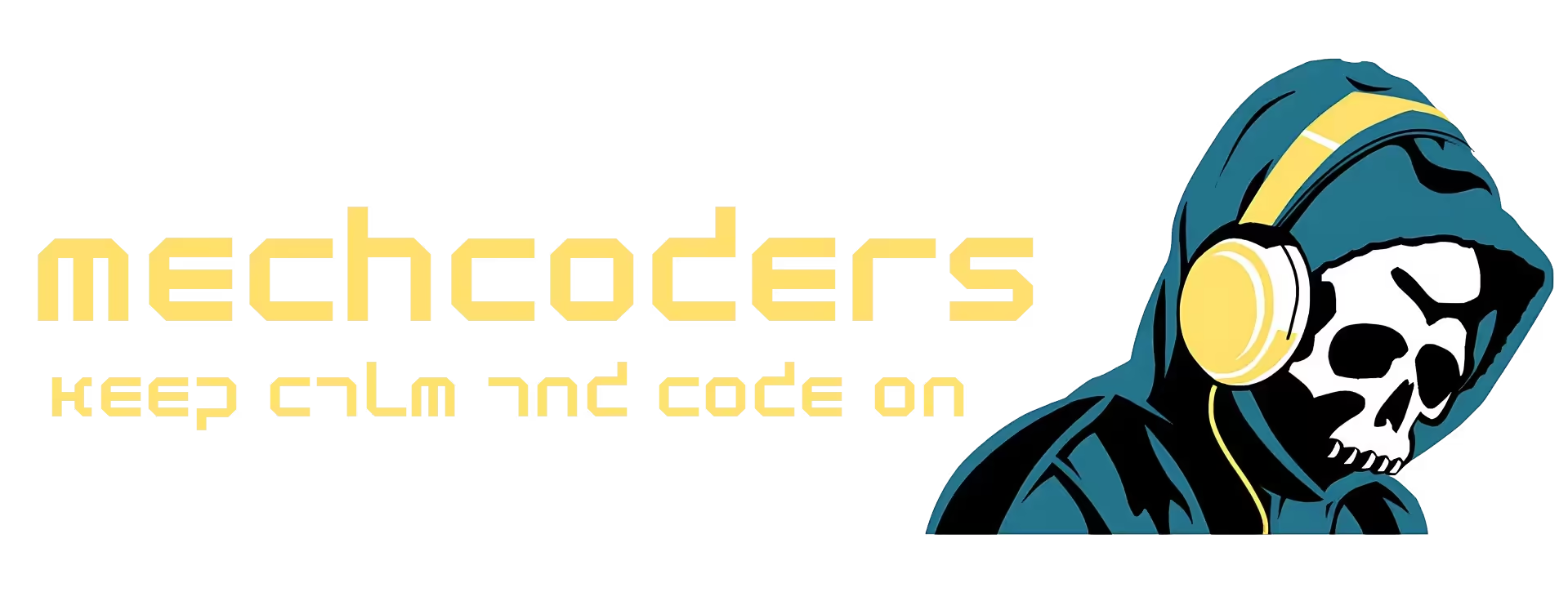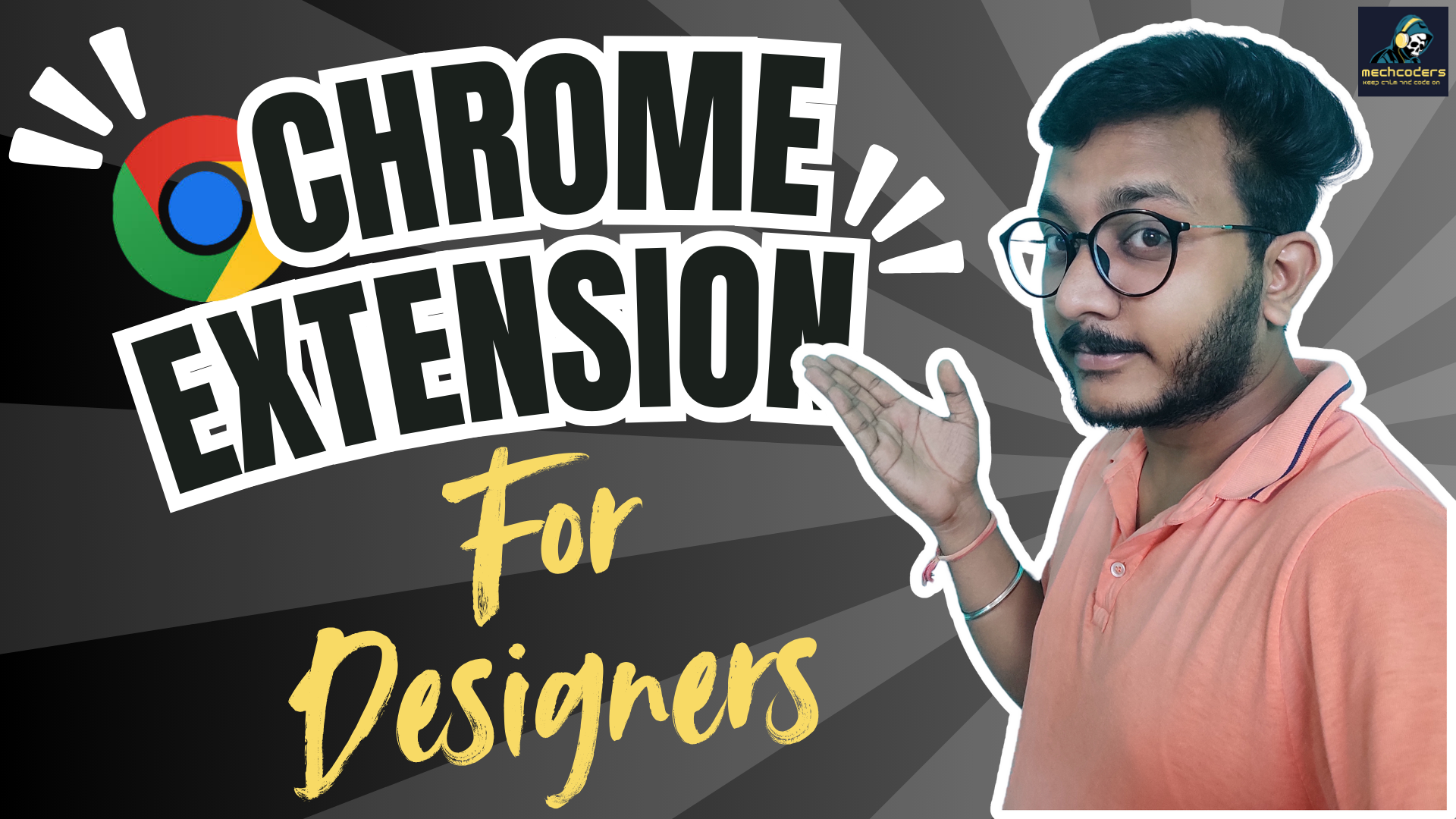Starting a blog may be precisely what you need. Writing blog posts as a business helps build trust between your readers and your brand. Blogging is a great way to express yourself, whether you’re an aspiring writer or have a hobby you’d like to document and share with others.
We’ve put together a comprehensive beginner’s guide to blogging to help you succeed. We cover everything from finding your niche, choosing and setting up a blogging platform, publishing content, and promoting your blog.
What is a Blog and why should you start blogging
Create a Useful Blog was often online diaries where people recorded their lives and hobbies. However, starting a blog today is commonplace for brands and individuals alike, and content is often an important part of a marketing strategy.
The reasons for starting a blog vary from person to person and from brand to brand. But if you’re looking for an extra nudge, there are many reasons you might want a blog.
Introduction: –
Blogs are a way to write and share your thoughts on a particular topic. The procedure is enjoyable and therapeutic for many people.
Communication With People:-
Blogging allows you to meet new people, build a blogging community, and make friends. If you’re an expert, it’s also a great way to connect with other experts in your field.
How to Create a Useful Blog with 10 Steps
By Create a useful Blog. You Can Learn And Develop New Skill Like Social Media Management, Writing, Web Development, and Many More.
are you looking for a blogging guide here you can find 10 steps toward your blogging
- Choosing A Blog Platform
- Get Web Hosting and Domain Name
- Setting Up WordPress For Create a Useful Blog
- Installation of Important WordPress Plugins & Theme
- Choose your niche & Focus Keyword
- Choose The Title to Create a Useful Blog
- Choose Content Topics To Create a Useful Blog
- Run a Pre-launch Campaign
- Promote Publish Content and Grow your Blog
- What to do After Your Blog is Ready ( Monetizing Your Blog )
1. Choosing A Blog Platform to Create a Useful Blog
When it comes to blogging platforms, the choices are endless. However, WordPress is the best choice for blogging. WordPress is used on 63.6% of all websites known as content management systems. this is 43.1% of all websites.
WordPress ( Content Management System )
a. OpenSource ( Free to Use )
One of the main reasons WordPress is so popular is that it is completely free, despite being the largest and most popular content management system in the world. It is free to install, download and use. and support videos are available in tons on youtube.
b. Update and Edit Your Blog From Anywhere and any Time
WordPress Provides the facility to edit your blog and update it with the help of the internet and a gadget.
c. Friendly With Search Engine
Compared to different platforms, WordPress is taken as consideration very appropriate for seek engines. The cause is the code in the back of WP which may be very smooth and simple.
Search engines which include Google and Yahoo like to study and index websites that can be simple, smooth, and aesthetically pleasing.
d. Easy to Make Responsive Web Design
With the big growth in cell tool utilization in current years, it’s miles critical to get responsive internet design. There are many responsive topics to be had in your WordPress blog.
e. No Need for HTML Code and FTP
An impartial platform that doesn’t require HTML-enhancing software programs including Dreamweaver, Adobe Contribute, etc. to create new internet posts, add images, and edit content. It`s no exaggeration to mention that WordPress offers you entire management over all components of your website.
f. User Friendly and Highly Customizable
WordPress is a beginner-pleasant platform. Since that is a content material control system, the consumer does now no longer need to do any form of internet coding to carry out obligations like adding new pages, blog posts, images, etc. The
platform is bendy and may be designed to fit your internet site needs. Additionally, the platform has an in-depth network of internet designers and internet builders who lay out a whole lot of appealing WordPress themes, layouts, templates, and plugins.
g. Ideal for Online Marketing
This is one of the most important benefits of selecting WordPress as you’re running a blog platform. In today`s online advertising scenario, developing sparkling content material in your target market is critical. WordPress affords a clean surrounding for updating your content material as you do not should undergo many complex steps to replace and post your content material.
Additionally, you could combine WP Blogs with numerous social media systems consisting including Facebook, Pinterest, Instagram, Google, etc. to proportion your posts without delay on those systems.
h. It is Ready to Go
Since WordPress turned into its first installation as a running blog platform, it has all of the capabilities a running blog platform must have. Easily combine WP blog capabilities which include e-mail subscriptions, RSS, and automated WP blog posting.
2. Get Web Hosting and Domain Name
This will give you access to your quota of resources to create a useful blog and maintain it. Most hosting companies, including Hostinger, offer different types of blog hosting. The two most popular blog hosting plans are:
a. Shared Hosting
Cheapest type of accommodation. In this type of blog hosting, the user shares server resources among several of his websites. Ideal for small sites like personal blogs. Shared hosting plans start at ₹69 per month.
b. WordPress Hosting
This type of shared hosting is specially optimized for WordPress websites. Starting at $69 per month, this plan is perfect if you want to use WordPress for a small blog.
All Hostinger hosting plans come with a free SSL certificate, and 24/7 live support, and are eligible for a 30-day money-back guarantee.
Once you’ve set up your hosting, it’s time to get a domain name for your blog. Visitors must enter their domain name in the address bar to access your site. A domain name makes visiting various websites easier and faster. This is because, without a domain name, users would have to memorize a long list of numbers (IP addresses of websites).
For example, mechcoders.com is a simple example of a wide range of extensions in the domain. To secure your blog domain name, purchase it from your domain registrar of choice. Some web hosting companies, including Hostinger, act as domain name registrars. Therefore, you can save time and money by purchasing web hosting and a domain name at the same time. When you purchase Hostinger hosting for 1 year or more, you also get 1 year of the free domain name. When choosing a domain name, make it memorable and as close to your blog name as possible. If you’re looking for inspirational domain name ideas, try Hostinger domain name checker.

Unique domain extensions such as .xyz, .online, and .club can make your blog name catchy and memorable.
For example, if you have a subscription or want your subscribers to feel like they belong, a .club domain is a good choice.
3. Setting Up WordPress To Create a Useful Blog
After purchasing and hosting your domain name with Hostinger, the next step is to activate WordPress. The foundation stone laying is complete. There are two main ways to install WordPress. domain name. One is very simple and straight forward and the other is a bit more complex, especially for beginners.
Installation With Auto-Installer
This simple method only takes Less Than a Minute. Like many major hosting providers, Hostinger offers this option in its User-friendly control panel Those can install WordPress with Single Click.
Here’s how to do it on Hostinger’s hPanel:
1. Navigate to Website -> Auto Installer.

2. Under WordPress, click Select.
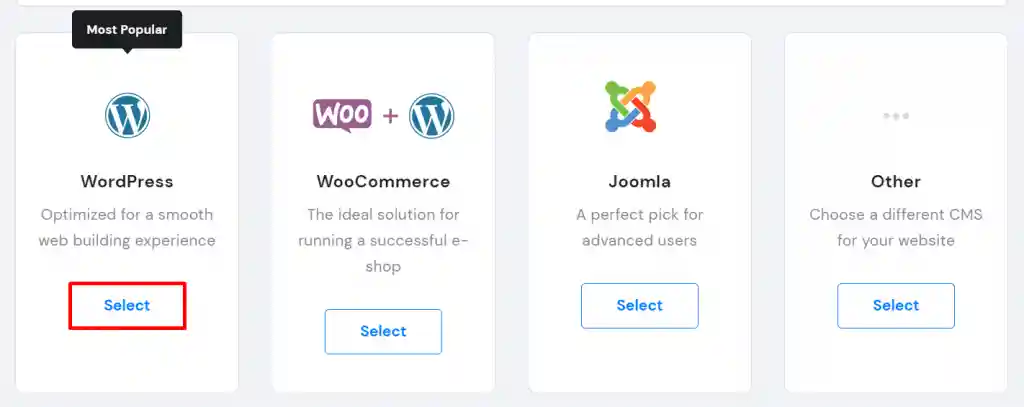
3. Next Step Will Appear On the Screen and Fill the Form with the Correct Details.
- Check the Correct Domain Name On Domain List.
- Fill in The Administrator Username, Password, and Email. All Details Will Use in the Future For Access to the WordPress Admin Panel.
- Enter your website name. I usually write my blog name here. You can change it later in the Site ID settings of your WordPress dashboard.
- Choose Your Preferred Language.
- Always Select the update to the latest available version to get the latest features and security Patch
- Select Install.
Once the installation is complete, log in to your WordPress admin. Here you can change your new blog. For now, let’s focus on designing and customizing a self-hosted WordPress blog. Learn about WordPress themes and how to customize them, plugins, and general site settings.
WordPress Login Process
To access your WordPress blog’s admin page, you need to visit yourwebsite.com/wp-admin. The admin login window will appear. Enter the username and password you created during the installation process. If you forgot your access data, click Forgot your password? Get options and credentials. Congratulations! You have reached the dashboard of your WordPress site.
WordPress General Settings
WordPress has various default settings that you can change to suit your needs. Most default settings don’t affect anything, but we think you should check common settings like intro line, site title, WP URL, site address, site language, time zone, date format, time format, etc. I’m here.
To access it, log into your dashboard and go to Settings -> General. The following page will appear in front of you. changes.

4. Installation of Important WordPress Theme & Plugins
Pick A Blog Theme to create a useful blog
A WordPress theme is a ready-to-use design template for your WordPress website that can be further customized. Both free and premium options are available in third-party sources, such as WordPress and Theme Forest libraries (Themeforest Library For Premium Theme For Purchase). The developer also offers premium themes on its site, such as the Astra theme. Fun Fact – There are more than 7400+ themes are only available in the official WordPress theme directory.
With the premium theme, you can expect access to dedicated support, regular updates, and premium plugins included with your purchase. While free WordPress themes are good enough for some successful blogs, they often offer little or no support, so premium themes are well worth the investment.
When it comes to installing themes, WordPress is pretty straightforward. Installing a professional WP theme will take a few minutes.
Here is the process: Go to Appearance -> Add New and find a theme that fits your business.

For Example, if you have a Philosophy Blog Simply type Philosophy in the search Philosophy blog the theme suggestion will appear on the screen choose one of them.
Next, click on the Install button and then Activate.
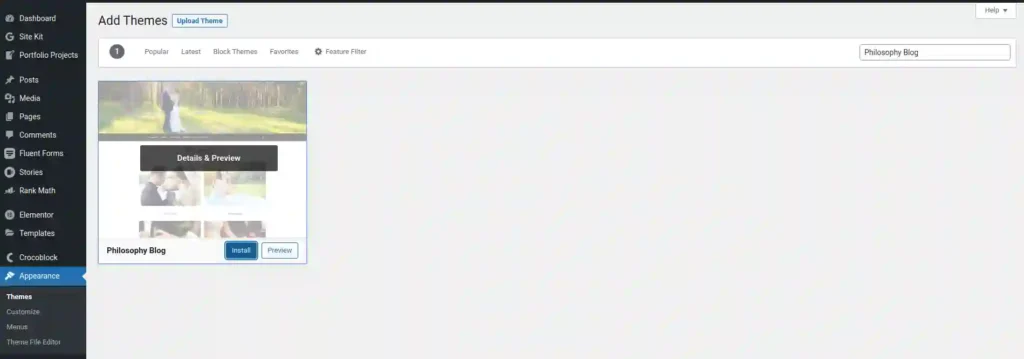
This method works well for free themes. But If you have a paid theme, you will need to Upload it manually on WordPress. To do this, you need to visit the Appearance section again, click on the Add New Theme button then Click On Upload Theme in Top Left Corner and select your theme.zip file (Download Theme Zip File). This Process Takes Some Time to Upload. Click Activate when you’re done.
Guidelines for an Ideal Theme for create a useful blog
- Choose a responsive theme that adapts the layout to your screen size and resolution. The themes will work perfectly with all major plugins and browsers.
- The theme code should be well organized. This is important from a search engine perspective.
- Make sure to have an active support forum for your topic so that your questions are answered quickly.
- Topics must be ready for translation. Don’t forget to check ratings and reviews on subjects. Help you choose the right one.
Design or create a useful Blog
After Activating or Installing the Theme It’s Time To Create a useful blog. but make sure that reading and browsing quality Experiences are good For your visitors.
here are some tips for those to increase your blogging quality.
- Install Drag and Drop, a Page Builder Plugin Like Elementor This Plugin will Help your Blog Website to take another level.
- Focus on User Experience Pick a SImple Color Combination, Layout design, and, Font That creates an interesting user experience
- Include Visual Representation Image add Images gallery in Your Blog to more attractive and engaging blog.
- Incorporated a Logo of the website that represents your brand If You don’t have a logo of your brand don’t worry you don’t need to hire a graphics designer you can create a logo for free instead hire a graphics designer.
- Icon Addon you should have icons in your blog with text like a social media icon and social share icon these are the best example of icons with the icon addon your blog looks more attractive to visitors.
- Add Creativity or take inspiration always keep learning to use creativity and take inspiration from everywhere and always curious for learning new.
Install Some Extra Plugins & Tools that increase your Functionality.
A WordPress plugin is a Bunch of code that extends the functionality of your website. Plugins provide additional functionality and can be installed, customized, and removed quickly. And the best part is that managing the plugin requires no coding knowledge. Different plugins Provide Different functionality. Some make your site more secure, some create backups, sign up for contact forms, moderate comments, add Google Analytics, and more. It is highly recommended that you take a look at the essential plugins below:
We recommend you check out the following essential plugins for create a useful blog
- Wordfence Security This Plugin Extendends your WordPress Security and it also allows to ReCaptcha option for preventing spam.
- UpdraftPlus & WP Vivid Both Plugins Provide a Backup and Restore functionality
- Fluent Form With This Plugin You can Create a Contact Form and Subscription form for Free.
- Akismet Spam Protection The name suggests that it is Spam Gaurd For Website.
- Monsterinsights This Plugin Connect Your website to Google Analytics accounts.
- Rank Math This plugin allows you to analyze your post content and edit title tags, meta descriptions, and more, all to help to improve your search engine ranking.
Similar to themes, there are great options for free and premium WordPress plugins. Premium usually comes with additional features and support. Some plugins are freemium. This means there is a free version available with basic features and you can upgrade by paying for the premium version.
Before choosing one plugin, check user ratings and reviews first. Some plugins lack regular updates and other important features or are poorly coded from the start. It’s safe to assume that the downloaded and highly-rated plugin will work just fine.
Too many plugins can slow down your site, so we recommend installing only the most essential ones. It also makes it difficult to update a large number of plugins. If you’re on shared hosting, get the most out of your server with up to 5 active plugins at the same time.
Install the plugin by logging into your WordPress admin dashboard and navigating to Plugins -> Add New. Browse or search for the plugin you want, install and activate it. Downloading third-party plugin files is similar to downloading a theme. Just select Upload Plugin. Like The Theme Upload option but in the plugin Section.
Constructing webpages for a blog website is essential
Webpages consist of the unchanging material of a website. In contrast to posts, a website page requires very few modifications or updates. The most frequent categories of pages on websites are as follows:
- Home page (Main Page) Your homepage is the Main Page of your website. This is what the visitor sees when he enters the domain name in the browser’s address bar. Your homepage should contain excerpts from your best and latest blog posts.
- About Page (information pages) This is an area of the website where visitors can learn more about the person behind the website and the brand in question. This page may include a bio, its purpose, and a profile picture.
- Contact Page This page describes how to contact the site administrator. Contact pages typically include email addresses, phone numbers, links to social media profiles, contact forms, or addresses and locations on Google Maps.
This Page is Basic That should be on Website but, it May vary as per demand, For example, if Your Blog is for a product review then You have to add a product page on your website.
To Create a Page you need to go to Dashboard and Navigate to Pages -> Add New. You Will be Taken to the Default WordPress Text editor. Use It to Write
5. Choose your Niche & Focus Keyword
Niche
Niche is a specific topic your blog focuses on and is essential in defining your target audience. A solid niche also helps you choose a name for your blog and develop a targeted blogging strategy.
Examples of niche blog ideas include books, travel, games, photography, and food. When creating a new blog, you may want to cover a variety of topics. However, mastering all subjects is difficult and unsustainable.
You can create a few successful, high-quality blog posts, but your audience will be scattered and it will be difficult to build a loyal audience. is important. Engaged viewers eagerly await your next content, bringing a steady stream of traffic to your blog.
To find the perfect niche for create a useful blog, consider the following tips.
- Use a Niche in which you have Strong Hand or Intrest in writing about those topics in which you have more interest or you have more knowledge regarding those topics.
Think about a hobby, interest, or topic you’d like to learn more about. If possible, be more specific, such as focusing on a specific dish (Japanese, Mexican, Italian), and don’t blog about anything food-related. Alternatively, you can run a reading blog that fits your budget or focuses on a particular writing style.
- Use a Niche On Public Intrest Based Writing About Those topics which user interest you can find easily on Google Trends for the public interest
This Way You can easily find what’s trending in your niche and which type of blog post you can inherit.
- You don’t have to be an expert to penetrate a niche Being a current professional has some perks that many readers ask for, but it’s not required. What’s more important is having a unique perspective on your topic and being interested in learning more.
Focus Keyword
Focus keywords are search terms that rank your post or page on search engines. So if your viewers search for a specific phrase or keyword in a search engine, they will likely find you. This knowledge base article explains what a Focus keyword is and how the Rank Calculator can help you choose the right Focus keyword.
a. Set The Focus Keyword
My favorite SEO plugin, Rank Math, has another field for adding focus keywords to posts/pages. To set your preferred keywords in Ranking Math, you need to edit your post/page and then navigate to the General SEO Math Ranking tab. Then enter the targeted keyword in the Targeted Keywords field.

You can get the most out of Rank Math’s content analysis by adding relevant keywords to the Focus Keywords section. The ranking calculator allows you to add up to 5 Focus keywords per post by default. However, all Rank Math PRO users can add unlimited keywords here. If you are using the free version, you can add keywords using this developer hook/filter. With that in mind, don’t overdo your main keyword or stuff it in your posts or pages. know More About Focus Keyword

6. Choose The Title to Create a Useful Blog
When you start blogging, you must first decide what the blog is about and what you want to achieve with your blog. Start by asking yourself the following questions and you’ll be in the best position to find and organize all of your blog titles.
Also, you should consider your motivation for blogging. Do you want to make money, educate, or just get inspired? Your name should indicate the purpose or location of your blog.
A Good Blog Name Contains
- Relevant to your niche Ideally, your readers should know who you are from your blog title.
- No more than 2-3 characters While some blogs with long names are very successful, we recommend keeping your name short and catchy.
- Easy to write and easy to remember Like your domain name, your blog name must pass the “pub test,” which means it should be fairly easy to type and remember, even if it’s being shouted across tables in a crowded bar.
Today We don’t need to spend too much time choosing a blog name. there are tons of AI blog Name Generators you can use for blog names free of charge.
all of This AI works with keywords only you need to give keywords and the AI Comes With a Different Name related to the Keywords simply choose the one name which you like most or add extra words and generate a new blog name.
7. Choose Content Topics To Create a Useful Blog
Once you’ve created your blog, it’s time to think about what you’re going to post. Start thinking about different topics and subtopics that are relevant to your chosen niche.
For Example: If You want to Blog About Food, Your Blogging Topics Could be
- Instant Recipes
- Indian Recipes
- Mistakes People While making Food
- Cooking advice for different seasons
after Deciding the topics and page setups now is time to discuss & expand each topic For Example The sub-topics for the blog
- Ingredients for recipe
- budget-friendly recipe
- review of the individual recipe
Use tools like Google Trends to help you understand what people are searching for and what kind of content already exists. You should also take a look at what your competitors are writing and what they think. Take note of what isn’t covered in detail in their post, and focus on including the missing information in your blog post. this will help you to rank on google.
During the actual writing process, it’s best to write a draft and revise it or have an editor proofread your copy. This way, you can avoid posting content full of Typo errors and other unintentional errors or mistakes.
8. Run a Pre-launch Campaign and Post a Blog
Before Posting a Blog you must do well before posting. A Well Step and sequenced blog are more successful. You need to choose the type of content you want to publish and the public posting schedule.
To Create a useful Blog. Here are mentioned Some Recommendations
- Specify Your Goal
- Identify The Targeted Audience
- Find a Competitor
- Check Out Online Groups Where you can find an audience
- List Down of Topics Which You will Write about
- Be Clear about Your Blog Content and simplify
- add Main Heading, Sub Heading, List, etc
- add Images And alternate words for the image
- Apply SEO Practice to add focus keywords, Meta Description, Tags
To create your first blog post, log into your WordPress dashboard and navigate to Posts -> Add New. The WordPress text editor, a tool for creating and formatting content, will appear. The WordPress text editor allows you to add and edit blocks or sections with different types of content. Blocks can contain a variety of text, media, design elements, widgets, and embeds. To select and add a new block, simply click the button at the top left of the editor. This is similar to Page Add and customize.
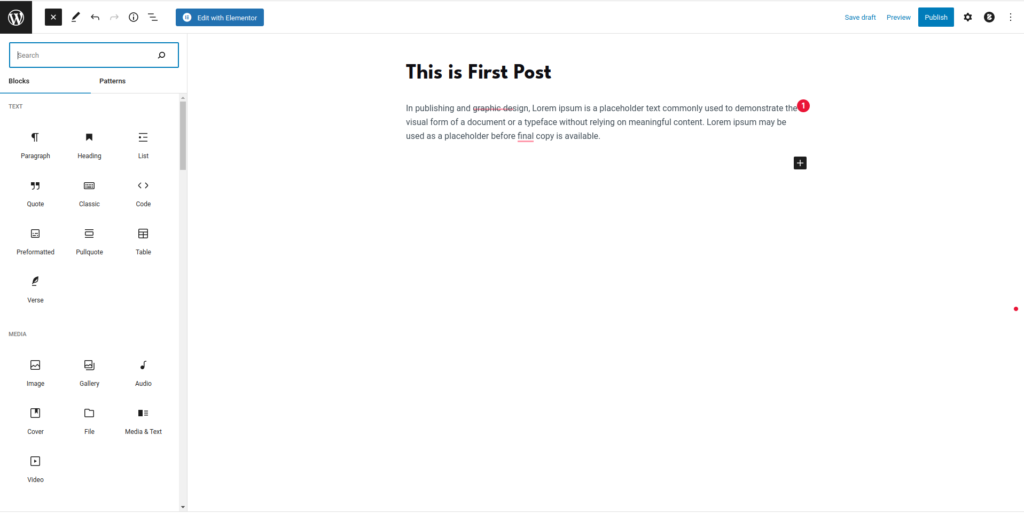
Once you’ve finished writing, formatting, and adding content to your first blog post, make sure your settings are correct before publishing. Like it Should be Visible to the public, Check The URL is Correct, The Template is Set to Default, and the author’s name should be right. To access the publishing settings, click the gear icon in the top right corner of the editor.
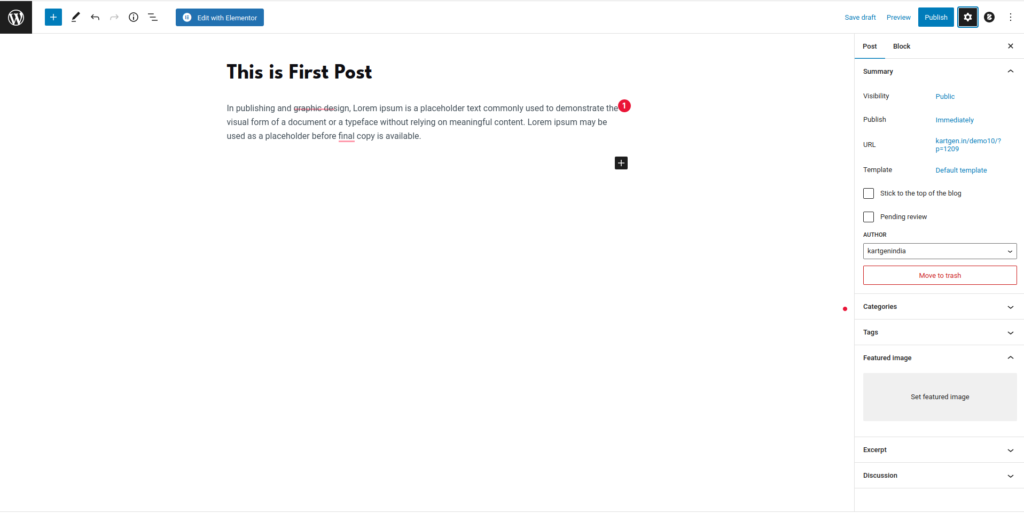
In the settings sidebar, you can choose to allow comments, add tags, set categories for your posts, or upload a Featured image of your choice. Before publishing your blog post, preview it to make sure it looks the way you want it to. For example, make sure your blog post title isn’t too long and that all paragraphs and images look good. Go back and edit your post if needed. If there are no problems, continue posting.
9. Promote Publish Content and Grow your Blog
Now that Our WordPress blog is Ready and got for Live, it’s time to get people to read your blog. It doesn’t matter how good your content is if it doesn’t reach your target audience. This is why blog promotion is important.
Optimize Your Blog With SEO Activity
Search Engine Optimization (SEO) is a technique That will Help to Increase Google Ranking Search.
Your website needs to rank well on search engine results pages (SERPs). as per BrightEdge, 53.3% of website traffic comes from organic search. If you have posts or pages that rank well on search engines, your blog can enjoy a steady stream of organic traffic without paying for ads.
Here are some Common tips for SEO Which Will Help Your SEO Ranking
- Focus on Keyword research. Target specific long-tail keywords with low competition to increase your chances of ranking well in the SERPs. Crawling keywords using tools like Google Trends, and SEMRush.
- Create an account for or log in via the existing account in Google Search Console This is an essential tool to monitor your website’s performance on Google. Find out which keywords are driving the most traffic and which sites are linking to your site.
- Install the SEO plugin. Rank Math SEO is one of the most popular SEO plugins if you run a WordPress blog. Some website builders also have built-in SEO features.
- Apply on-page SEO best practices Important on-page SEO tactics include optimizing images, adding meta descriptions, and changing the permalink slug.
- Improve website performance Fast page speed has a positive impact on SEO. To speed up your website, follow our website performance guidelines.
Through Social Media, You can build Your Audience
Promoting your blog on social media and online forums is a great way to find and connect with your audience. Your goal is to find a community around your blog area and refer them to your blog to increase traffic. 97% of bloggers use social media to publish their articles.
It’s a popular way to drive traffic, but like other ways, the competition is fierce. Therefore, it is very important to focus your time and energy on a sound social media strategy. The first step is to make sure you incorporate social media into your blog. Readers who find your content interesting or valuable are more likely to follow your social media accounts and share your content with others.
If you have a WordPress blog, there are plenty of social media plugins that you can use. Once installed, you will be able to access the social network and sharing tools, Facebook buttons, and more.
The next step is to decide on which social media platforms you want to promote your blog. Each social media platform has its idiosyncrasies, and not all are right for your particular niche. That’s why it’s important to research the demographics of each platform before you start advertising on social media.
There are Some Social Media Flatform Where YOu can Pramot Your WordPress Blog Like
- Tik Tok
By Email Marketing Tactics, You can Also Promote Your Blog
Email marketing is sending emails to a group of people promoting your blog. Even in the age of social media, email marketing is still an effective way to maintain a readership for a personal blog. It should be noted that it also has the highest ROI compared to other marketing methods.
Many web hosts offer their customers dedicated email accounts. If your website platform doesn’t include email, consider purchasing a separate email hosting service. This allows you to create a professional email account, such as hello@mechcoders.com
Here Are Some Required Steps for Email Marketing
- Choose the right email marketing tool
- Build an email list of the audience
- create a high-quality email and send
10. What to do After Your Blog is Ready
so Finally all things are set and your blog is ready for publication but the important thing has left the Monetization of Your Blog. This will be an opportunity to make money blogging. We Can Make Money From Blogs in a lot of ways. Some of the most popular methods include:
- Affiliate marketing By becoming an affiliate of a brand, bloggers can use affiliate links to earn money. Every time a blog visitor purchases through the affiliate link, the affiliate brand earns a commission of around 5-30% of the product’s sale price.
- Paid advertising Bloggers can include ad space on their site by joining an ad network. Ad networks like Google AdSense help bloggers quickly connect with brands that are relevant to their target audience.
- Sponsored posts Contact brands to get paid to write about their products. Before you do this, make sure your blog has a good audience and traffic.
- digital and physical products Create an e-commerce site for your blog and sell physical and digital products related to your content. For example, by selling digital products like online courses and e-books include your blog posts more in-depth. Sales of physical goods are also worth considering. registered users.
- User Subscription Create exclusive content that visitors can unlock by signing up for a membership page or a separate blog segment. Maintain the value of your subscription by consistently delivering unique, high-quality content.
Conclusion
Blogging has many benefits for your personal and professional growth, from gaining authority on a topic to generating extra income for your own business. Better yet, creating your own blog and starting your blogging journey is now easier and more affordable than ever.
In this guide, we break down all the steps to becoming a blogger, from defining “what should I blog about?” to choosing and setting up the right platform for your blog, publishing content, promoting your blog, and monetizing it.
We hope this article Will help you learn how to create a Useful blog and Making Money from it. Let us know If You Have any Questions In Your Mind reaching us Out Commenting Below
We hope you find this article helpful. Feel free to explore our other posts on Mechcoders Blogs.
If you liked this article, then please subscribe to our YouTube Channel for WordPress video tutorials. You can also find us on Linkedin and Facebook.
Create a useful blog Create a useful blog Create a useful blog Create a useful blog Create a useful blog Create a useful blog Create a useful blog Create a useful blog Create a useful blog Create a useful blog Create a useful blog Create a useful blog Create a useful blog Create a useful blog Create a useful blog Create a useful blog Create a useful blog Create a useful blog Create a useful blog Create a useful blog
Create a useful blog Create a useful blog Create a useful blog Create a useful blog Create a useful blog Create a useful blog Create a useful blog Create a useful blog Create a useful blog Create a useful blog Create a useful blog Create a useful blog Create a useful blog Create a useful blog Create a useful blog
